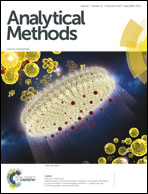Highly sensitive electrochemical detection of bisphenol A based on the cooperative enhancement effect of the graphene–Ni(OH)2 hybrid and hexadecyltrimethylammonium bromide
Abstract
Graphene sheets (GSs) are first easily prepared via one-step solvent exfoliation of graphite powder in N-methyl-2-pyrrolidone (NMP) and then hybridized with Ni(OH)2 microparticles. The resulting insoluble GS–Ni(OH)2 hybrid is readily dispersed in water in the presence of surfactant hexadecyltrimethylammonium bromide (CTAB). Compared with the bare glassy carbon electrode (GCE), CTAB, pristine GS, Ni(OH)2, and GS–Ni(OH)2 composite modified GCEs show enhanced oxidation signal for bisphenol A (BPA). Based on the cooperative enhancement effect of the solvent-exfoliated graphene–Ni(OH)2 hybrid and CTAB, a novel electrochemical sensor with high sensitivity is developed for the detection of BPA. Under the optimal conditions, the detection limit (S/N = 3) is estimated to be as low as 5.0 nM. In the end, the fabricated electrochemical sensor is successfully used to determine the content of BPA in real water samples.


 Please wait while we load your content...
Please wait while we load your content...